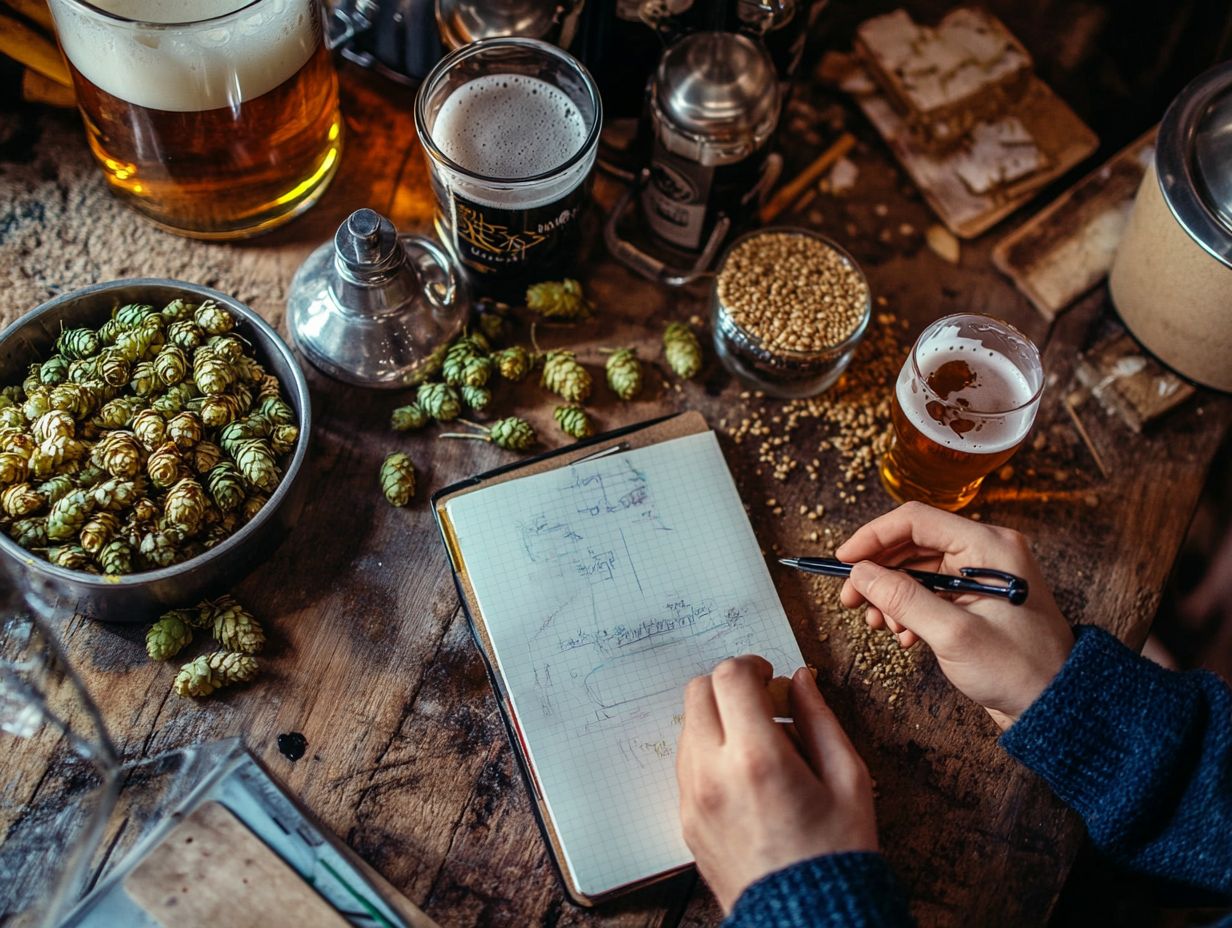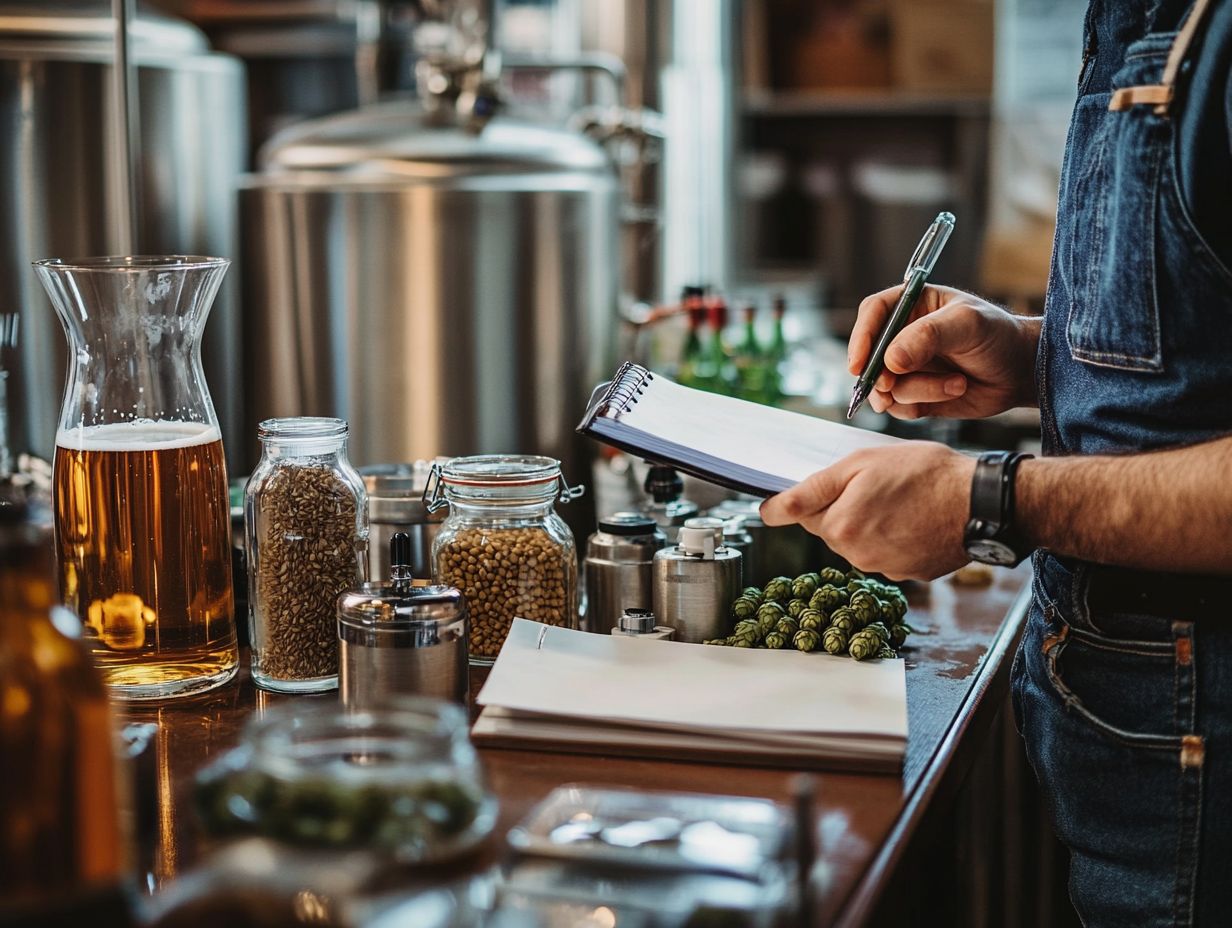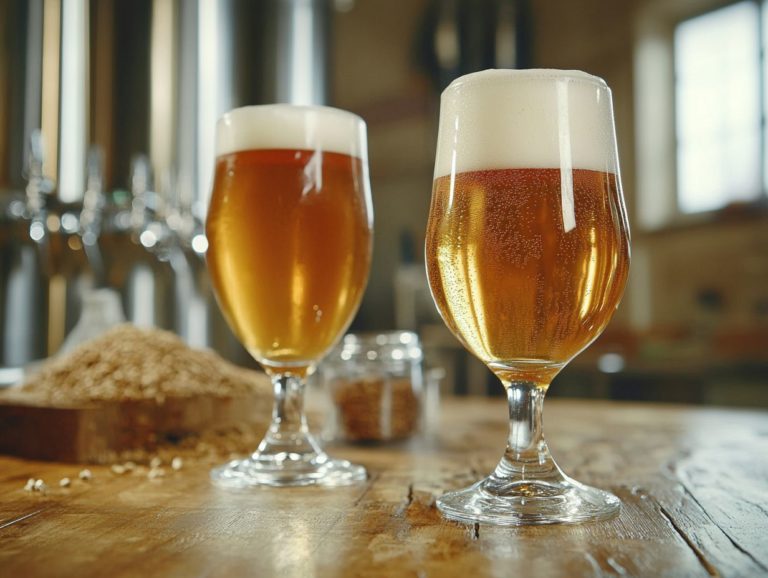5 Techniques to Troubleshoot Your Brewing
Brewing your own beer can be a truly rewarding endeavor, yet it certainly comes with its fair share of challenges. This is especially true when considering the complexities of the fermentation process and water chemistry involved.
Whether you re a seasoned homebrewer or just stepping into this fascinating world, grappling with issues like fermentation troubles or unexpected off-flavors can be incredibly frustrating. Understanding the role of yeast nutrients and the importance of a high final gravity (FG) can significantly improve your results.
Get ready to discover five game-changing techniques to troubleshoot your brewing process! We will guide you through checking your brewing equipment and ingredients, examining water quality, and making temperature adjustments. It also covers the importance of monitoring the original gravity (OG) and final gravity (FG) during fermentation.
We ll highlight common mistakes and provide valuable brewing tips on enhancing clarity and maintaining sanitation. Discover how to elevate your homebrew game and ensure that every batch achieves the success you strive for!
Contents
- Key Takeaways You Can t Miss!
- 1. Check Your Equipment
- 2. Inspect Your Ingredients for Flawless Brew
- 3. Adjust Your Temperature and Timing
- 4. Consider Your Water Quality
- 5. Seek Advice from Experienced Brewers
- Why Is My Beer Not Fermenting Properly?
- Master Your Brewing Process
- Frequently Asked Questions
- What are the 5 techniques to troubleshoot your brewing process?
- Why is it important to check your equipment when troubleshooting brewing issues?
- How can adjusting water chemistry help troubleshoot brewing problems?
- Why is monitoring fermentation crucial in troubleshooting brewing issues?
- How can reviewing recipe ingredients help troubleshoot brewing problems?
- What cleanliness precautions should you take when troubleshooting brewing problems?
- Frequently Asked Questions
Key Takeaways You Can t Miss!

- Check your brewing equipment regularly to ensure it is clean and functioning properly to avoid issues during the brewing process.
- Pay attention to the quality of your ingredients, including freshness and proper measurements, to ensure the best possible flavor in your beer.
- Temperature and timing play a crucial role in the success of your brew; make sure to monitor and adjust accordingly for optimal results.
1. Check Your Equipment
Before you plunge into the intricate world of coffee brewing or beer brewing, ensuring your equipment is in impeccable condition is essential. This means everything from a high-quality machine to a meticulously clean burr grinder, as each component plays a significant role in crafting the perfect cup or pint and elevating the entire brewing experience.
The choice of brewing equipment can dramatically shape the flavor profile of your final cup. For example, a French press will deliver a completely different taste compared to a drip coffee maker, thanks to variations in water temperature and extraction times.
Similarly, in beer brewing, equipment like a CO2 tank and pressure regulator are crucial for maintaining the right carbonation levels. Maintaining a clean grinder is vital; old coffee oils can easily taint fresh grounds, robbing you of the exquisite flavor you seek.
Getting the grind size just right is crucial, whether you lean toward a coarse or fine finish. This directly impacts how your coffee extracts during brewing. For beer, using the right grind size when milling your grains ensures better extraction and efficiency during the brewing process.
Every piece of equipment, especially when well-maintained, contributes uniquely to achieving a harmonious balance of flavor and aroma in each delightful sip of coffee or beer.
2. Inspect Your Ingredients for Flawless Brew
The quality of your coffee is intricately tied to the ingredients you select. Taking a moment to examine your coffee setup, ensuring you re grinding the beans just right, and measuring out the perfect amount of filtered water are essential steps for achieving that ideal brew.
Similarly, when brewing beer, the quality of your water and ingredients like hops and malt play a crucial role in the final taste. Choosing high-quality coffee beans is crucial to unlocking rich flavors and enticing aromas, as the freshness and origin of the beans can profoundly influence the overall taste profile.
The grind size is another critical factor that directly impacts extraction. If your grind is too fine, you might end up with a bitter cup, while a grind that s too coarse could leave you with a lackluster brew. The choice of hops in beer brewing will affect the International Bitterness Units (IBUs), which measure the bitterness in beer, and overall flavor balance.
Opting for filtered water can significantly enhance the purity and flavor of your coffee, as it removes impurities that might otherwise compromise the taste. To keep your coffee fresh, it s wise to store it in an airtight container, away from light and moisture, and to regularly check for any off odors or overly stale aromas before brewing.
For beer, using filtered tap water and brewing salts can optimize water chemistry for better flavor extraction. By considering these elements, you will undoubtedly elevate your coffee experience to new heights.
3. Adjust Your Temperature and Timing
Temperature and Timing
Temperature and timing adjustments are crucial in the brewing process, as these elements directly impact how well you brew and the taste of your coffee, ensuring that each cup reaches its full potential.
Brewing Methods
Each brewing method, whether it s pour-over, French press, or espresso, demands specific temperature settings and precise timing to extract the best flavors and aromas from the coffee grounds.
For example, using boiling water on delicate beans can result in unpleasant bitterness, while under-extracting may cause you to miss out on those delightful nuances you crave. In beer brewing, incorrect fermentation temperature can introduce undesirable off-flavors and affect yeast efficiency.
Avoiding Pitfalls
By understanding and following these individual parameters, you can avoid common mistakes that often lead to a subpar cup. Ultimately, honoring these requirements not only elevates the overall taste but also transforms your brewing ritual into a more pleasurable and fulfilling experience.
Understanding the brewing process for beer is also essential, as maintaining consistent temperatures can greatly improve your final product.
4. Consider Your Water Quality

The Importance of Water Quality
Water quality is a critical yet often overlooked aspect of your coffee brewing routine. By using filtered water with balanced chemistry, you can dramatically enhance the taste and overall quality of your coffee.
Enhancing Flavor Extraction
Consider incorporating brewing salts, which are minerals added to water that help improve the taste of your brew, to further enhance flavor extraction. This is equally important in beer brewing, where water quality and the use of brewing salts like calcium sulfate and magnesium chloride significantly impact the final flavor profile.
Minerals and Flavor Release
The minerals in your water have a significant impact on how flavors are released during the brewing process. It s essential to choose water that perfectly complements your coffee beans. If your water is too hard or too soft, it might lead to undesirable taste profiles that overshadow the rich notes of high-quality beans.
Creating an Optimal Environment
For those who take their brewing seriously, adding specific brewing salts like calcium sulfate or magnesium chloride can create an optimal environment for flavor release, ensuring that your final cup is both well-rounded and satisfying. In beer brewing, these salts help maintain water chemistry that complements the specific brew method you’re using.
Transforming Your Experience
Paying careful attention to water quality transforms your coffee into an unforgettable experience that you ll truly savor.
5. Seek Advice from Experienced Brewers
Learning from Experts
Learning from experienced brewers offers invaluable insights and expert tips that can help you sidestep common coffee mistakes, paving a smoother path toward mastering the art of brewing.
Engaging with Communities
Whether you are brewing coffee or beer, experienced brewers can guide you through common pitfalls and advanced techniques. Actively engaging with local brewing communities and attending workshops can significantly enhance your knowledge and skills.
Gaining Hands-On Experience
By immersing yourself in these interactive environments, you gain hands-on experience and have the opportunity to share your personal stories and techniques with fellow enthusiasts. Programs at microbreweries or coffee workshops can provide profound insights and practical skills.
Discovering New Methods
This vibrant exchange of ideas can lead you to discover new methods and flavors that might otherwise slip under your radar. Following online forums also provides a fantastic way to connect with others, facilitating a valuable exchange of feedback and advice.
Such collaborations enrich your brewing journey, transforming it into a shared and communal experience that fosters growth in your techniques.
Why Is My Beer Not Fermenting Properly?
When you’re brewing beer, encountering issues with fermentation can be quite frustrating. Common causes for improper fermentation include inadequate yeast nutrients, incorrect fermentation temperatures, and insufficient oxygen levels. Addressing these issues is essential for a successful brewing process.
The health of your yeast is very important; it significantly influences the outcome of your brew. If your yeast isn’t healthy or has been stored incorrectly, you may face sluggish fermentation or even a complete stall.
The environment within the fermentation tank is equally crucial. Contaminants or excessive foam can disrupt the process, making it essential to maintain a clean and controlled setting. Keep an eye on the original gravity (OG), which serves as a baseline for gauging fermentation progress.
If you face issues, provide enough oxygen when pitching the yeast and adjust the fermentation temperature to resolve them. Using a Corny keg and a CO2 tank helps maintain the right carbonation levels in your beer.
How Can I Identify and Fix Off-Flavors in My Beer?
Identifying and fixing off-flavors in beer requires a good understanding of the brewing process and how fermentation temperature and yeast selection can affect it. By recognizing these critical elements, you can elevate your final product.
By focusing on these factors, you can trace the origins of any unpleasant tastes that may appear during fermentation. If you experience excessive temperature fluctuations, your yeast may produce undesirable esters or phenols, leading to flavors often described as fruity or medicinal. To counter this, always maintain a consistent fermentation temperature within the yeast s optimal range.
Choosing the right yeast is equally critical; each type brings a unique flavor profile. Familiarizing yourself with the characteristics of various strains enables you to select one that matches the intended style of beer, ensuring a more enjoyable final product.
What Are the Most Common Mistakes Made by Homebrewers?

As a homebrewer, you may grapple with common mistakes that can derail your brewing plans. Understanding these pitfalls is essential for crafting high-quality beer and avoiding issues like improper sanitation and fermentation mishaps.
Sanitation is a critical aspect you must always prioritize. Contaminated equipment can introduce unwanted bacteria and wild yeast, sabotaging even your most meticulously crafted recipes. To prevent this, adopt strict sanitation protocols and use solutions like Star San or bleach to clean all your tools, containers, and surfaces. Remember that a clean grinder and filtered water are essential for maintaining high standards.
Maintaining optimal fermentation conditions is also crucial. Fluctuations in fermentation temperature can lead to off-flavors or stalled fermentation, so choose yeast that thrives within specific temperature ranges. Monitor your fermentation vessel for signs of trouble, and keep track of your original gravity (OG) and final gravity (FG) to ensure fermentation is progressing properly.
Water quality often flies under the radar, but it can significantly impact flavor. Sourcing good-quality water or using filtration systems can enhance your final product immensely. Adjusting your water chemistry with brewing salts can also help achieve the desired taste profile.
By being mindful of these crucial aspects, you can elevate your brewing game and consistently enjoy remarkable results. Using the right brew method and incorporating brewing tips enhances both the efficiency and quality of your brewing process.
Key Tips for Successful Homebrewing
- Always maintain strict sanitation protocols.
- Choose the right yeast for your beer style.
- Monitor fermentation temperatures closely.
- Use quality water and adjust your water chemistry.
- Be attentive to signs of fermentation trouble.
Have you faced any challenges while brewing? Feel free to share your experiences or tips in the comments below!
How Can I Improve the Clarity of My Beer?
Improving the clarity of your beer is crucial for a successful brewing process. You can enhance clarity through various techniques:
- Proper yeast management
- Utilizing a secondary fermentation tank
- Employing fining agents when appropriate
- Using a high-quality machine to ensure precision
Your choice of malt and hops also significantly impacts clarity. If not managed properly, they can introduce haze into your brew. One effective method to improve clarity is cold crashing, which encourages yeast and other particulates to settle at the bottom of your fermenting container. Remember to measure the IBU levels correctly to avoid unwanted bitterness.
Incorporating filtration techniques will help remove any remaining haze-causing particles before packaging your beer. Using filtered tap water will ensure no impurities affect the clarity.
Maintaining consistent fermentation temperatures and ensuring that your yeast is fully attenuated before packaging are essential steps in creating bright, clear beer. By focusing on these aspects and avoiding common coffee mistakes like not grinding beans properly or using the wrong grind size, you can significantly elevate the overall appearance and quality of your final product. If you encounter any issues with your brewing equipment, check out this guide on how to troubleshoot brewing equipment issues. Experiment with these tips in your next brewing session!
What Are the Best Sanitation Practices for Homebrewing?
Proper sanitation practices are vital in homebrewing. They safeguard your brewing equipment and prevent contamination that could spoil your precious batch of beer.
From cleaning your kettles and fermenters to meticulously sanitizing every tool and surface you touch during the brewing process, your attention to detail is key. Follow the example of industry leaders like Sierra Nevada and their famous Celebration Ale.
Make sure to use a measured amount of cleaning solution for maximum effectiveness. Using filtered water is another crucial component, as any impurities can drastically impact flavor and fermentation. Consider using filtered tap water or white rice in your cleaning routine for thorough sanitation.
It s also essential to adopt methods that shield against wild yeast and bacteria. Cover open vessels with sanitized lids and employ airlocks during fermentation. Deploying a CO2 tank and pressure regulator can help maintain an anaerobic environment.
By adhering to these sanitation techniques, you cultivate a cleaner brewing environment and elevate the overall quality and consistency of your final product. This makes your brewing process more efficient and yields better results.
How Can I Troubleshoot a Stuck Fermentation?
Troubleshooting a stuck fermentation is an essential skill for you as a homebrewer. Identifying root causes such as insufficient yeast nutrients, incorrect fermentation temperature, or inadequate oxygen levels can significantly influence your brewing success.
Keep tabs on your original gravity (OG) and aim for a high final gravity (FG) to diagnose issues early. Understanding the nuances of these factors can make all the difference in achieving that perfect batch.
Consulting brewing programs and engaging with a local microbrewery can provide valuable insights. If fermentation seems to have stalled, checking the fermentation temperature of your fermenter is wise. Raising it by just a few degrees might reignite the yeast s activity.
Adding yeast nutrients can supply essential elements that your yeast needs to thrive, effectively revitalizing sluggish cells. Oxygenating the wort before fermentation will enhance yeast performance, ensuring a smooth resumption of the process. Using a secondary fermentation tank can provide additional space for yeast activity.
By implementing these strategies, you can turn a stalled fermentation into a successful brewing experience, elevating your homebrewing skills to new heights. Don t forget to utilize a Corny keg for efficient storage and dispensing.
Master Your Brewing Process
Frequently Asked Questions

What are the 5 techniques to troubleshoot your brewing process?
The 5 techniques to troubleshoot your brewing process are:
- Checking your equipment
- Adjusting water chemistry
- Monitoring the fermentation process
- Reviewing recipe ingredients
- Taking cleanliness precautions
Why is it important to check your equipment when troubleshooting brewing issues?
Checking your equipment is crucial. Any malfunction can affect your beer’s quality. It’s best to catch and fix any issues before they result in a bad batch.
How can adjusting water chemistry help troubleshoot brewing problems?
Water chemistry plays a significant role in your beer’s flavor and characteristics. Adjusting the pH level and using brewing salts can help improve the overall taste and address any off-flavors.
Why is monitoring fermentation crucial in troubleshooting brewing issues?
Fermentation is a delicate process. Changes in fermentation temperature, yeast health, or oxygen levels can impact the final product. By monitoring fermentation, you can catch and address any issues before they affect the quality of your beer.
How can reviewing recipe ingredients help troubleshoot brewing problems?
The ingredients in your recipe greatly impact the flavor, aroma, and appearance of your beer. By reviewing and adjusting your recipe, you can troubleshoot issues and create a more balanced and enjoyable brew.
What cleanliness precautions should you take when troubleshooting brewing problems?
Maintaining cleanliness is vital in brewing. Any contamination can lead to off-flavors and negatively affect fermentation. Proper cleanliness precautions, such as sanitizing equipment and following cleaning procedures, can help troubleshoot issues and maintain the quality of your beer. Tools like a CO2 tank and pressure regulator can also be pivotal.






